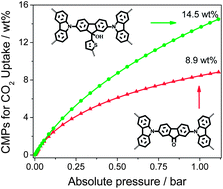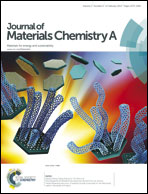Design and synthesis of novel carbazole–spacer–carbazole type conjugated microporous networks for gas storage and separation†
Abstract
Two novel conjugated microporous networks, P-1 and P-2, with carbazole–spacer–carbazole topological model structures, were designed and prepared by FeCl3 oxidative coupling polymerization. Monomer m-1 (fluorenone spacer) was modified with a thiophene Grignard to form the fluorenyl tertiary alcohol monomer m-2, and this step can increase the polymerization branches from four to five and incorporate the polar –OH group into the building block. N2 adsorption isotherms show that, after modification, the Brunauer–Emmett–Teller (BET) surface area of P-2 (1222 m2 g−1) is two times that of P-1 (611 m2 g−1), and the total pore volume increases 1.63 times from 0.95 to 1.55 at P/P0 = 0.99. However, the domain pore size (centred at 1.19 nm) and the pore distribution of both networks are not changed. It demonstrates that the domain pore width may be determined by the size of the rigid carbazole–spacer–carbazole backbone, not the degree of crosslinking when the networks were prepared under same polymerization conditions in this system. Hydrogen physisorption isotherms of P-1 and P-2 show that the H2 storage can be up to 1.05 wt% and 1.66 wt% at 77 K and 1.1 bar, and the isosteric heat is 9.89 kJ mol−1 and 10.86 kJ mol−1, respectively. At 273 K and 1.1 bar, the CO2 uptake capacity of P-2 can be up to 14.5 wt% which is 1.63 times that of P-1 under the same conditions. The H2 and CO2 uptake capacities of P-2 are among the highest reported for conjugated microporous networks under similar conditions. The CO2/CH4 and CO2/N2 selectivity results indicate that P-1 exhibits a slightly higher separation ability than P-2. There is often a trade-off between absolute uptake and selectivity in other microporous organic polymers. Fine design and tailoring the topological structure of the monomer can change the adsorption isosteric enthalpy and optimize the gas uptake performance. The obtained networks with the carbazole–spacer–carbazole rigid backbone show promise for potential use in clean energy applications and the environmental field.


 Please wait while we load your content...
Please wait while we load your content...